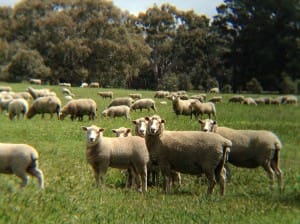 CENTRAL Tablelands New South Wales sheep producers will learn how to identify unproductive ewes and the causes of lamb mortality at a workshop on September 15.
CENTRAL Tablelands New South Wales sheep producers will learn how to identify unproductive ewes and the causes of lamb mortality at a workshop on September 15.
NSW DPI Livestock Research Officer Dr Gordon Refshauge said without a “wet and dry”, research indicates about a quarter of the ewes in a flock could be rearing 8 percent of the lambs and be responsible for 60pc of losses, so identify the dry ewes so you can find them in the future.
Lamb mortality – not lamb weaning – rates are the real indicator of a successful lambing and ewe management is a vital factor in delivering healthy lambs, he said.
Dr Refshauge will show producers at the MLA-supported Mandurama Pasture Update on September 15 how performing a lamb autopsy can identify the most likely cause of death.
“You can’t manage what you don’t measure.
“Many producers assume lamb mortality is due to foxes or cold weather, but mostly that isn’t the case,” he said.
Brain injury is major mortality contributor
Dr Refshauge said research showed brain injury was a leading contributor to lamb mortality, as it reduced the lamb’s drive to suckle, interfered with bonding and impacted its ability to keep warm. Brain injuries in lambs can be minimised when pregnant ewes are managed better and selected to rear lambs.
“The best way to improve lamb survival in the short term is better ewe management, by ensuring they have adequate nutrition which provides for a good birth weight of lambs, and also excellent early vigour, good mothering behaviour and milk let-down.
“Over a longer term, improvements come from selecting for the ewe’s rearing ability,” he said.
The lamb mortality ‘tool kit’
Dr Refshauge’s ‘tool kit’ includes judicious ram choice, shelter during lambing and predator control, but he said the top three factors which can impact lamb survival are:
Nutrition: Adequate ewe nutrition translates to better foetal growth, survival and lactation. The risk of dystocia increases for both light and heavy lambs, so aim to lamb ewes in condition score 3 and avoid weight loss in the last 50 days before lambing. Twin lambing paddocks should offer about 1500kg DM/ha of high quality (75pc digestible) feed at the start of lambing and remain above 1000kg DM/ha. Start at 1000kg DM/ha for single bearing ewes for the lambing period. Feeding 400gms/head/day of lupins for twin bearing ewes for two weeks before and two weeks after lambing improves colostrum, milk yield, lamb survival and weaning weight, even when ewes are in lush pastures.
Assessing reproductive performance: Learn how to identify ewes that have successfully lambed and reared or have failed to lamb or rear, by doing a ‘wet and dry’. Give ewes in self-replacing flocks a second chance, but cull after their second failure to rear. A quarter of the ewes rear 8pc of the lambs and are responsible for 60pc of the losses so identify the dry ewes, so you can find them in future.
Pregnancy scanning: Scanning 40 days after rams are removed identifies ewes that need the most care and supports feed and stock flow budgeting. From around day 100 after joining (last 50 days before lambing), preferentially manage the ewes carrying twins giving them the best feed. At lambing allocate twin bearing ewes to shelter paddocks with good pasture (at least 1500 kg DM/ha). Don’t lamb in mobs greater than 400 for singles and 200 for twins, and reduce this by 50 for maiden ewes. Don’t lamb at rates of more than 10 ewes/hectare. Use tools like MLA’s feed budget or CSIRO’s Pastures from Space to plan ahead.
More information: Dr Gordon Refshauge, [email protected]
- How to check ewes for wet and dry udders:https://www.youtube.com/watch?v=ceL3i5IdOxo
The update will be held from noon until 5:30pm at Stuart and Gemma Green’s Chesney Pastoral property at 1576 Burnt Yards Rd, Mandurama, opposite the Errowanbang woolshed. The $20 cost includes lunch and afternoon snack. RSVP: By Friday, September 11, is essential for catering purposes to Phil Cranney (Central Tablelands LLS) on (02) 6363 7888 or email [email protected]
Source: Meat and Livestock Australia.

And you can feed out molasses or salt block supplements as well that helps ewes digest more feed, and meet mineral requirements. Also pregnancy test every year and have a ‘no mercy’ policy on any dry ewes. Simple really.